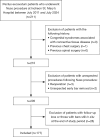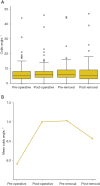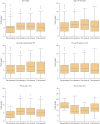Impact of the Nuss procedure on spinal curvature across four time points: a longitudinal and subgroup analysis
- PMID: 40809263
- PMCID: PMC12340301
- DOI: 10.21037/jtd-2025-357
Impact of the Nuss procedure on spinal curvature across four time points: a longitudinal and subgroup analysis
Abstract
Background: Pectus excavatum (PE) and scoliosis are widely reported to be highly associated due to the anatomical relationship between the thorax and spine. While the Nuss procedure is commonly performed to correct PE, its impact on spinal alignment remains unclear. The aim of this study is to investigate the effect of Nuss procedure on spinal curvature dynamics across different stages of the Nuss procedure.
Methods: This retrospective study analyzed 177 patients who underwent the Nuss procedure for PE correction between July 2011 and July 2024. Spinal curvature was evaluated by measuring Cobb angle (CA) at four stages: pre-operative, post-operative, pre-removal, and post-removal. Subgroup analyses were performed based on sex, age, thoracic morphology (symmetry), pre-operative Haller index (HI), and baseline CA to assess their influence on CA dynamics.
Results: Significant changes in CA were observed during the bar insertion and maintenance phases (pre-operative to post-operative: mean difference +1.09°, P=0.003; pre-operative to pre-removal: mean difference +1.12°, P=0.03). Subgroup analyses of CA dynamics across the four time points identified male sex (P=0.001), adolescence (10-19 years, P=0.047), asymmetric thoracic morphology (P=0.04), severe HI (HI ≥3.5, P=0.01), and baseline CA (both <10°, ≥10°, P<0.001) as key factors influencing these changes. Among patients with CA <10°, mean CA changes were 2.05°±3.59° after bar insertion and 2.10°±4.20° before removal. Conversely, in the CA ≥10° (scoliosis) group, mean changes were -3.60°±4.32° and -3.70°±4.37°, respectively. No significant CA changes were found between the pre-operative and post-removal stages.
Conclusions: This study investigates the dynamic impact of the Nuss procedure on spinal curvature, with the most pronounced changes occurring during bar insertion and the maintenance phase. Yet, no significant changes were observed between the pre-operative and post-removal stages. Spinal alignment shifts throughout different stages of the procedure and is influenced by multiple factors, particularly sex, age, and pre-operative CA. Further research is needed to explore the underlying biomechanical mechanisms and to assess the long-term effects of PE correction on spinal alignment.
Keywords: Nuss procedure; Pectus excavatum (PE); scoliosis; spinal curvature.
Copyright © 2025 AME Publishing Company. All rights reserved.
Conflict of interest statement
Conflicts of Interest: All authors have completed the ICMJE uniform disclosure form (available at https://jtd.amegroups.com/article/view/10.21037/jtd-2025-357/coif). The authors have no conflicts of interest to declare.
Figures



Similar articles
-
Does the Nuss procedure for treating pectus excavatum compromise the long term internal mammary artery flow? A systematic review.J Card Surg. 2021 Jul;36(7):2518-2523. doi: 10.1111/jocs.15576. Epub 2021 May 20. J Card Surg. 2021. PMID: 34018244
-
Prescription of Controlled Substances: Benefits and Risks.2025 Jul 6. In: StatPearls [Internet]. Treasure Island (FL): StatPearls Publishing; 2025 Jan–. 2025 Jul 6. In: StatPearls [Internet]. Treasure Island (FL): StatPearls Publishing; 2025 Jan–. PMID: 30726003 Free Books & Documents.
-
How Does Anterior Vertebral Body Tethering Compare to Posterior Spinal Fusion for Thoracic Idiopathic Scoliosis? A Nonrandomized Clinical Trial.Clin Orthop Relat Res. 2025 Jun 19. doi: 10.1097/CORR.0000000000003575. Online ahead of print. Clin Orthop Relat Res. 2025. PMID: 40537949
-
Therapeutic exercises for idiopathic scoliosis in adolescents.Cochrane Database Syst Rev. 2024 Feb 28;2(2):CD007837. doi: 10.1002/14651858.CD007837.pub3. Cochrane Database Syst Rev. 2024. PMID: 38415871 Free PMC article.
-
Braces for idiopathic scoliosis in adolescents.Cochrane Database Syst Rev. 2015 Jun 18;2015(6):CD006850. doi: 10.1002/14651858.CD006850.pub3. Cochrane Database Syst Rev. 2015. PMID: 26086959 Free PMC article.
References
LinkOut - more resources
Full Text Sources
Medical
